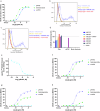Structure elucidation of a human melanocortin-4 receptor specific orthosteric nanobody agonist
- PMID: 39353917
- PMCID: PMC11445563
- DOI: 10.1038/s41467-024-50827-7
Structure elucidation of a human melanocortin-4 receptor specific orthosteric nanobody agonist
Abstract
The melanocortin receptor 4 (MC4R) belongs to the melanocortin receptor family of G-protein coupled receptors and is a key switch in the leptin-melanocortin molecular axis that controls hunger and satiety. Brain-produced hormones such as α-melanocyte-stimulating hormone (agonist) and agouti-related peptide (inverse agonist) regulate the molecular communication of the MC4R axis but are promiscuous for melanocortin receptor subtypes and induce a wide array of biological effects. Here, we use a chimeric construct of conformation-selective, nanobody-based binding domain (a ConfoBody Cb80) and active state-stabilized MC4R-β2AR hybrid for efficient de novo discovery of a sequence diverse panel of MC4R-specific, potent and full agonistic nanobodies. We solve the active state MC4R structure in complex with the full agonistic nanobody pN162 at 3.4 Å resolution. The structure shows a distinct interaction with pN162 binding deeply in the orthosteric pocket. MC4R peptide agonists, such as the marketed setmelanotide, lack receptor selectivity and show off-target effects. In contrast, the agonistic nanobody is highly specific and hence can be a more suitable agent for anti-obesity therapeutic intervention via MC4R.
© 2024. The Author(s).
Conflict of interest statement
T.F., S.T., L.D., N.S., A.B., T.L., S.D.C., M.D., C.V., K.S., S.S., R.V., N.L., M.V.R., and C.M. are current and L.P., V.-P.J., Z.S., M.M., Y.-L.L., J.O., and R.B. are former employees of Confo Therapeutics. The remaining authors declare no competing interests.
Figures






References
-
- Clément, K. et al. MC4R agonism promotes durable weight loss in patients with leptin receptor deficiency. Nat. Med.24, 551–555 (2018). - PubMed
-
- Kühnen, P. et al. Proopiomelanocortin deficiency treated with a melanocortin-4 receptor agonist. N. Engl. J. Med.375, 240–246 (2016). - PubMed
-
- Mountjoy, K. G. et al. The cloning of a family of genes that encode the melanocortin receptors. Science257, 1248–1251 (1992). - PubMed
-
- Maaser, C. et al. Role of the melanocortin system in inflammation. Ann. N. Y. Acad. Sci.1072, 123–134 (2006). 2006. - PubMed
Publication types
MeSH terms
Substances
Associated data
- Actions
Grants and funding
LinkOut - more resources
Full Text Sources

